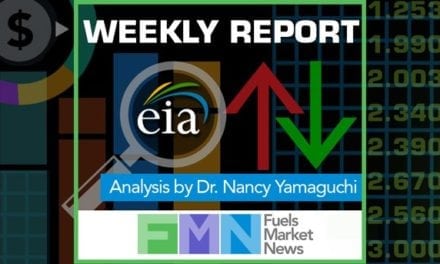Brexit pressures prices lower
- Impact of UK vote to leave EU far-reaching
- Colder winter on tap: NOAA
- Drill rig count rising
- Natural gas storage tops 3 Tcf
Table covers crude oil and principal products. Other products, including residual fuel oil and “other oils” are not shown, and changes in the stocks of these products are reflected in “Total Petroleum Products.” Statistics Source: Energy Information Administration “Weekly Petroleum Status Report” available at www.eia.doe.gov
The Matrix
The vote by Britain to leave the European Union has created a chaotic situation for global financial markets. Crude oil prices fell about five per cent. August WTI futures settled at $47.64 on Friday, June 24th. Prices have since softened further, but this may reflect bearish seasonality as much as it does European uncertainty.
The impact on oil prices has been muted, reflecting the changing reality of new demand coming from emerging countries of Asia. Oversupply remains a significant driver for price in the near term.
The implications of the UK vote are far reaching and will play out over the next several years. Most immediately, we expect bearish results for energy prices as the value of the dollar rallies in a flight to quality.
Behind the headlines, however, several things given less attention were affecting product markets. These included potential changes in the long term weather outlook, a potential change in the drilling outlook, and pressure on global refining capacity.
El Niño, the warm winter phenomenon, officially ended in May. Last winter’s poor heating degree day showing is now likely to be replaced by El Niño’s counter, La Niña. The National Oceanic and Atmospheric Administration (NOAA) believes there is a 75 per cent chance that La Niña will develop by winter.
La Niña is not as widely reported as is El Niño. It is generally good news for weather-dependent energy sellers. Its criteria include
- Sea surface temperatures (SST) in the Equatorial Pacific Ocean at least 0.5°C (0.9°F) cooler than the average in the preceding month
- Expectation that the cooler SSTs will continue,
And one or more of the following:
- stronger than usual easterly trade winds,
- an increase in cloudiness and rainfall over Indonesia and a corresponding drop in average surface pressure,
- a decrease in cloudiness and rainfall in the eastern tropical Pacific, and an increase in the average surface pressure.
Higher crude oil prices have apparently affected the outlook for new production in the United States. The Baker-Hughes weekly report showed U.S. oil drillers adding rigs for the third consecutive week. Nine rigs were added, bringing total rigs to 337. This was about half the number of rigs in action last year, but before the recent turn, drillers “added rigs in only three of 23 weeks this year.”
Implications of more rigs for higher production need to be tempered by consideration of Drilled-but-Uncompleted wells (DUCs) still in place. Drilled-but-Uncompleted wells may be brought into play before many new rigs are deployed. One analyst believes that almost all DUCs are economic at $50 per barrel. He estimates 1,978 oil wells and 2,084 gas wells are DUC in the backlog. This translates into first-year 400,000 barrels of daily oil production.
Lower prices have encouraged product demand. In the United States, gasoline demand reached 9.8 million barrels daily, an all-time record. Demand growth has led to record global refining capacity. One estimate puts refining capacity at 101.8 million barrels per day in August, up from 97.25 million barrels daily in March. Strong crude oil demand should increase gasoline stocks and soften gasoline crack spreads over the balance of the year.
Supply/Demand Balances
Supply/demand data in the United States for the week ending June 17, 2016 were released by the Energy Information Administration.
Total commercial stocks of petroleum increased 5.2 million net barrels during the week ending June 17th, 2016.
Builds were reported in stocks of gasoline, distillates, propane, and other oils. Draws were reported in stocks of crude oil, fuel ethanol, K-jet fuel, and residual fuel oil.
Crude oil supplies in the United States decreased to 530.6 million barrels, a draw of 0.9 million barrels.
Crude oil supplies decreased in three of the five of the PAD Districts. PAD District 2 (Midwest) crude oil stocks declined 0.8 million barrels, PADD 3 (Gulf Coast) stocks fell 1.2 million barrels, and PADD 4 (Rockies) crude oil stocks decreased 0.4 million barrels. Supplies increased in PAD District 1 (East Coast) by 1.1 million barrels and PADD 5 (West Coast) by 0.4 million barrels from the previous week.
Cushing, Oklahoma inventories decreased 1.3 million barrels to 65.2 million barrels.
Domestic crude oil production decreased 39,000 barrels daily to 8.677 million barrels per day.
Crude oil imports averaged 8.439 million barrels per day, a daily increase of 817,000 barrels.
Refineries used 91.3 per cent of capacity, an increase of 1.1 percentage points from the previous report week.
Crude oil inputs to refineries increased 188,000 barrels daily; there were 16.505 million barrels per day of crude oil run to facilities. Gross inputs, which include blending stocks, increased 210,000 barrels to 16.718 million barrels daily.
Total petroleum product inventories saw an increase of 6.1 million barrels from the previous report week.
Gasoline stocks increased 0.6 million barrels; total stocks are 237.6 million barrels.
Demand for gasoline increased 54,000 barrels per day to 9.815 million barrels daily.
Total product demand decreased 830,000 barrels daily to 20.010 million barrels per day.
Distillate fuel oil supply increased 200,000 barrels; total stocks are 152.3 million barrels. National distillate demand was reported at 3.902 million barrels per day during the report week. This was a weekly increase of 86,000 barrels daily.
Propane stocks increased 1.2 million barrels to 79.6 million barrels. Current demand is estimated at 1.011 million barrels per day, a decrease of 8,000 barrels daily from the previous report week.
Natural Gas
According to the Energy Information Administration:
Net injections into storage totaled 62 Bcf during the storage report week, compared with the five-year (2011-15) average of 88 Bcf and last year’s net injection of 77 Bcf during the same week. As a result, the surplus in storage compared with the five-year average declined from the previous week to 678 Bcf, and the surplus compared with year-ago levels decreased to 618 Bcf. The year-over-year storage surplus fell for the eleventh consecutive week.
Working gas stocks topped 3,000 billion cubic feet (Bcf) during the first week of June—earlier in the refill season (April 1 – October 31) than ever before. The last time stocks reached this threshold in June was during the week ending June 15, 2012. Comparable to 2012, working gas stocks entered the refill season this year at a record high level, totaling 2,492 Bcf on March 31, 19 Bcf above the previous 2012 record.
Futures trading involves significant risk and is not suitable for everyone. Transactions in securities futures, commodity and index futures and options on future markets carry a high degree of risk. The amount of initial margin is small relative to the value of the futures contract, meaning that transactions are heavily “leveraged”. A relatively small market movement will have a proportionately larger impact on the funds you have deposited or will have to deposit: this may work against you as well as for you. You may sustain a total loss of initial margin funds and any additional funds deposited with the clearing firm to maintain your position. If the market moves against your position or margin levels are increased, you may be called upon to pay substantial additional funds on short notice to maintain your position. If you fail to comply with a request for additional funds within the time prescribed, your position may be liquidated at a loss and you will be liable for any resulting deficit. Past performance may not be indicative of future results. This is not an offer to invest in any investment program.
Powerhouse is a registered affiliate of Coquest, Inc.
Was this helpful? We’d like your feedback.
Please respond to [email protected]
or call: 202 333-5380
Copyright © 2016 Powerhouse, All rights reserved.












